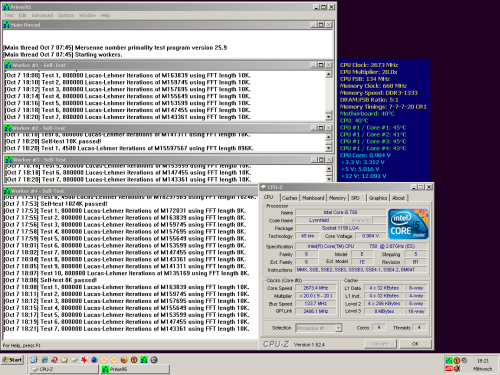Index
Page 2 of 10
ASRock P55 Pro:
Features:
Intel P55
4 dual-lane phases + 2-phase VRM
ST L6716 VRM controller cpu-portion
ST L6743 VRM controller northbridge-portion
Realtek RTL8111DL PCIe Gb LAN controller
JMicron JMB363 PCIe SATA II/PATA controller
VIA VT6308P PCI firewire controller
Nuvoton (Winbond company) NCT6771F super I/O controller
Realtek ALC888
ICS 9LPRS140CKLF clock generator
passive cooling of chipsets/VRM
16Mb BIOS, version: 1.70 - 2.00
Mainboard Revision: 1.00
Slots:
2x PCIe 2.0 x16, 1x x16 or 2x x8
2x PCIe 2.0 x1 @ x0.5 speed
2x PCI
Memory:
4x Dual-Channel DDR3-slots for PC3-10667U memory up to 16GB
Storage:
6-Port SATA II featuring RAID 0, 1, 5, 0+1, JBOD
1-Port PATA
1-Port Floppy
Backpanel ports:
1x PS/2 keyboard
1x PS/2 mouse
1x Gb LAN
1x Firewire
8x USB 2.0
2x eSATAp II
7.1 analog audio
1x optical audio out
1x digital audio out
1x CMOS clear button

Accessories:
4x SATA cables with clips
1x PATA cable
1x Floppy cable
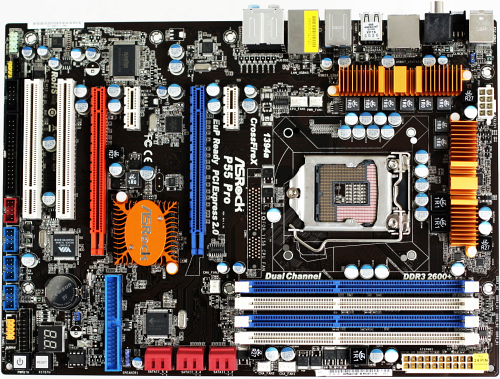
Layout:
This is an entry board and from the looks of it, it shows. That board was built to appeal to the mass-market at a very reasonable price-level. At least the BIOS offers all features to overclock and ASRock put some effort in adding some additional features into the BIOS. Also you notice the 2/3 ATX size which is not really cool, because all the parts are crammed together and you miss some of the mounting holes.
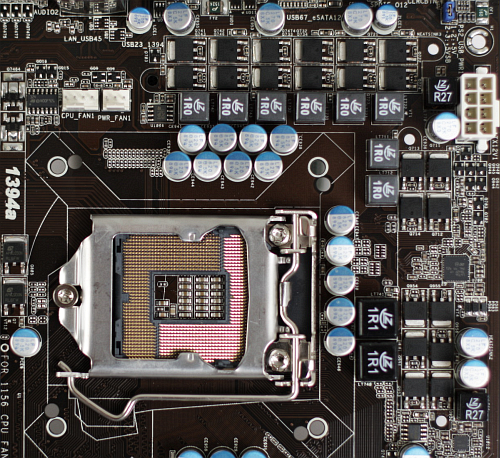
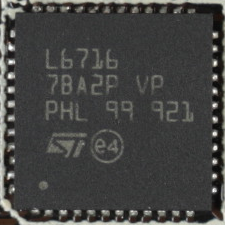
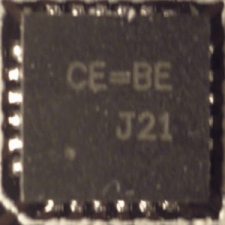
The VRM is an analog 4-phase dual-lane design without any fancy stuff. ASRock is using an ST VRM controller which have not been seen on other boards yet. Due to the price level the VRM is a very cheap design and that shows in power-consumption tests. Of course you would need some time to save the price differences to other boards, but better VRM designs do also keep the CPU cooler. As long as you don't apply high overclocks, the VRM won't cause a problem.
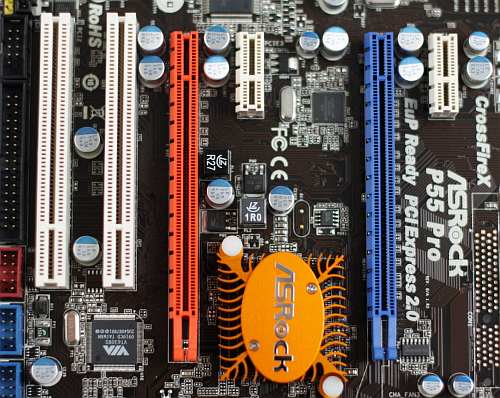
The slot design is very straightforward and the best of all boards. Two PCIe 2.0 x16 slots give you the capability to use Crossfire. SLI is not possible out of the box, because at this price-level ASRock decided not to pay the extra SLI tax. Both PCIe x1 slots will not be blocked by any graphics cards which we like much.
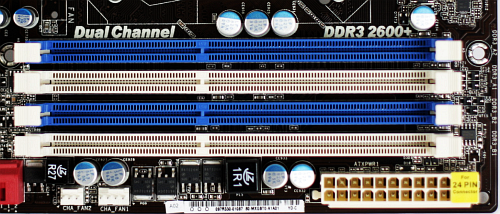
The memory slots are close to the CPU socket. Because the PATA is behind the 2nd PCIe x16 slot, it's not that bad and the power connector has been moved to the right bottom edge of the board.
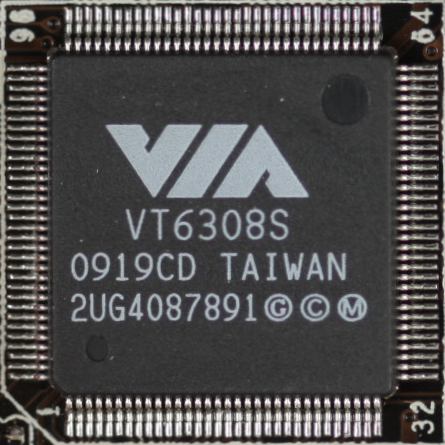
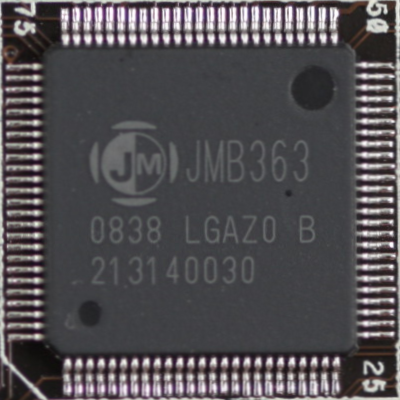
Not surprisingly the board features the Realtek RTL8111DL GbLAN solution. And to shave of some cents of the BOM (bill of materials) ASRock uses only an ALC888, not the latest ALC889. The JMB363 provides the two ports for eSATA and the one PATA port. The most unusual choice is the integration of the VIA VT6308P PCI firewire-controller instead of it's PCIe pendant.

The SATA connectors are on the edge of the board and all of them are angled at 90°. This is the best solution available because the connectors won't interfere with any cards, especially with such a small board. Sadly the PATA connector is connected quite odd, parallel to the second PCIe x16 slot, but nowadays PATA is not needed any more.
BIOS:
What we never like is, over-voltaging with default settings. There is no merit whatsoever to increase the VTT/QPI voltage to 1.219V when Intel specifies 1.100V. Same goes for DRAM voltage at 1.615V compared to the specified 1.500V in a non-overclocked environment. We insisted that ASRock includes under-voltage controls so you can come close to the specified voltages manually. VTT/QPI can be lowered now to 1.114V, DRAM to 1.489V which works happily with our modules. Also the default settings for Windows 2000 configuration is inconvenient with Floppy enabled, COM1 enabled, and SATA as compatible. When using performance or other default BIOS settings the Turbo inside of the CPU-settings vanishes mysteriously which is not a good idea if you like to overclock. Also disabling NX-Bit and HPET is a really bad idea, especially with Windows XP, Vista and Windows 7.
Since BIOS 2.00 the board clocks on the spot when set to manual, perfect. We insisted that ASRock fix this, because it does not make sense to under- or overclock boards on stock settings:
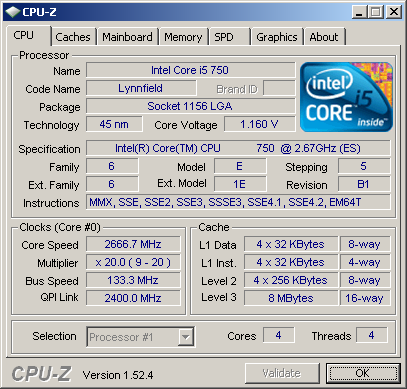
Surprisinglythe board did manage to overclock to 200MHz virtual FSB with 4GHz:

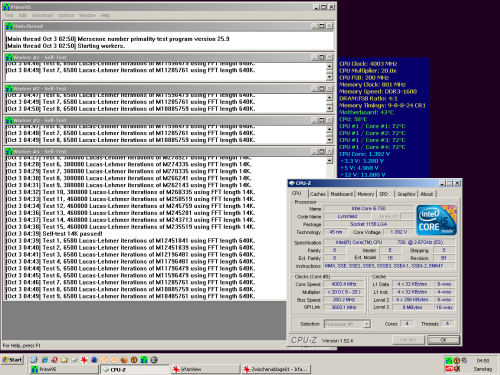
Of course due to the new BIOS we also tried under-voltaging the CPU without Turbo-Mode with only 1.03125VCore and 1.039V VTT/QPI which worked perfectly, so we can't understand why ASRock has decided to increase the VTT on stock settings by over 0.1V:
